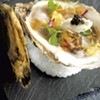Published August 7, 2013 at 6:53 a.m.
It’s a tiny pest that swept into the country four years ago from its home in northern Japan. Not much larger than the tip of a pen, it uses its sharp, serrated ovipositor to slice a microscopic hole into a berry, where it lays eggs that grow into hungry larvae. Oh, and that hole is so microscopic, you wouldn’t really know it’s there until the ripe berry rots from the inside.
Meet Drosophila suzukii, otherwise known as spotted-wing drosophila, a tiny, invasive and cold-hardy fruit fly that has the potential to devastate late-season berry crops for both farmers and home gardeners if left unchecked.
“Soft fall crops are at risk,” notes Vern Grubinger, a vegetable and berry specialist at University of Vermont Extension who has been tracking the fly’s spread across Vermont. Once the female fly punctures the fruit, her eggs will hatch into larvae within 10 to 14 days and begin eating the fruit — what Grubinger drily calls “making jam.”
Unlike the fruit fly most of us know and loathe from our kitchens (the vinegar fly, which prefers rotting fruit), the spotted-wing drosophila just needs a ripe berry to do its thing. The hole it makes is so tiny, says Grubinger, that an infestation won’t become apparent until late in the season, usually mid-August on. Yet rotting fruit is not the only tip-off. “When you’re really in the thick of it, you can go out at dusk and there are swarms of these things around,” he says.
Spotted-wing drosophila swept into Vermont with Tropical Storm Irene, and southern Vermont berry growers first noticed it last year. Both farmers and researchers have been busy devising ways to fight the pest, including with homemade traps and insecticides.
Grubinger has seen some success with netting trials, he says, but the nets that growers need to use must have holes smaller than 1 millimeter and be secured fully so that the fly can’t get in. In other words, it’s expensive. “For anyone with larger acreage, it will be challenging,” he says.
An informal survey of a few northern Vermont berry growers indicated that the pest hasn’t showed its face much so far this year. But it’s late-season raspberries and blueberries — and Vermont’s limited crops of cherries, peaches and grapes — that will be most affected, warns Grubinger.
Adam Hausmann of Adam’s Berry Farm in Burlington’s Intervale first saw signs of the pest last August, “at which point it was present for the rest of the season,” he reports in an email. Identifying the scourge wasn’t hard. “When you harvest, the inside of the berry is wet, somewhat liquified. The good thing is that it makes it easy to detect, the bad is the fruit is unmarketable. For blueberries, they shrivel and drop to the ground, usually. When you pick them up and look inside, they have the same liquid appearance.”
Hausmann, who’s moving his farm to Charlotte because of Intervale flooding, thinks organic berry growers face a trickier fight. Unable to use most sprays, the other preventative measures — netting, picking ripe fruit daily, and chilling the fruit before sale —are all cumbersome, pricey or not ideal. “It’s a real challenge for organic growers,” Hausmann says. “Without proper control, it will be devastating.”
Still, Grubinger is confident that with proper vigilance and controls, those who raise berries in Vermont can beat this pest, or at least reduce its numbers. “Home growers will be taken by surprise if they haven’t been paying attention,” he says. “The key thing is picking [fruit] promptly, and putting it in the fridge right away seems to work.”
As for the possibility that we’re all chowing down on drosophila eggs when we have berries for breakfast? Don’t worry about it, says Grubinger. “We eat insect eggs all of the time without knowing it.”
More By This Author
Comments
Comments are closed.
From 2014-2020, Seven Days allowed readers to comment on all stories posted on our website. While we've appreciated the suggestions and insights, right now Seven Days is prioritizing our core mission — producing high-quality, responsible local journalism — over moderating online debates between readers.
To criticize, correct or praise our reporting, please send us a letter to the editor or send us a tip. We’ll check it out and report the results.
Online comments may return when we have better tech tools for managing them. Thanks for reading.















































